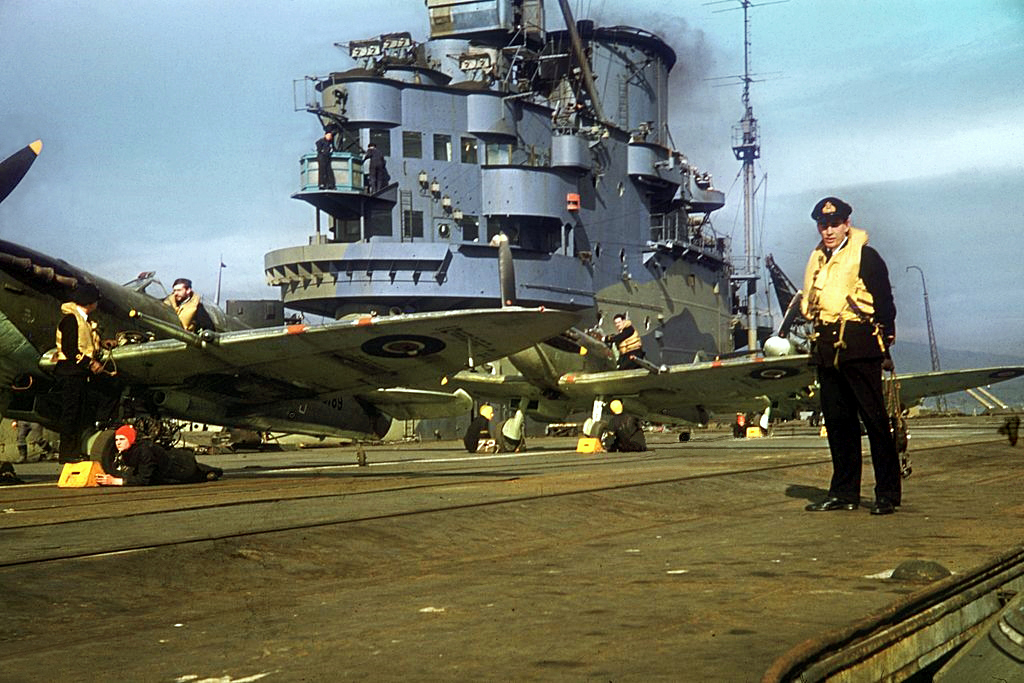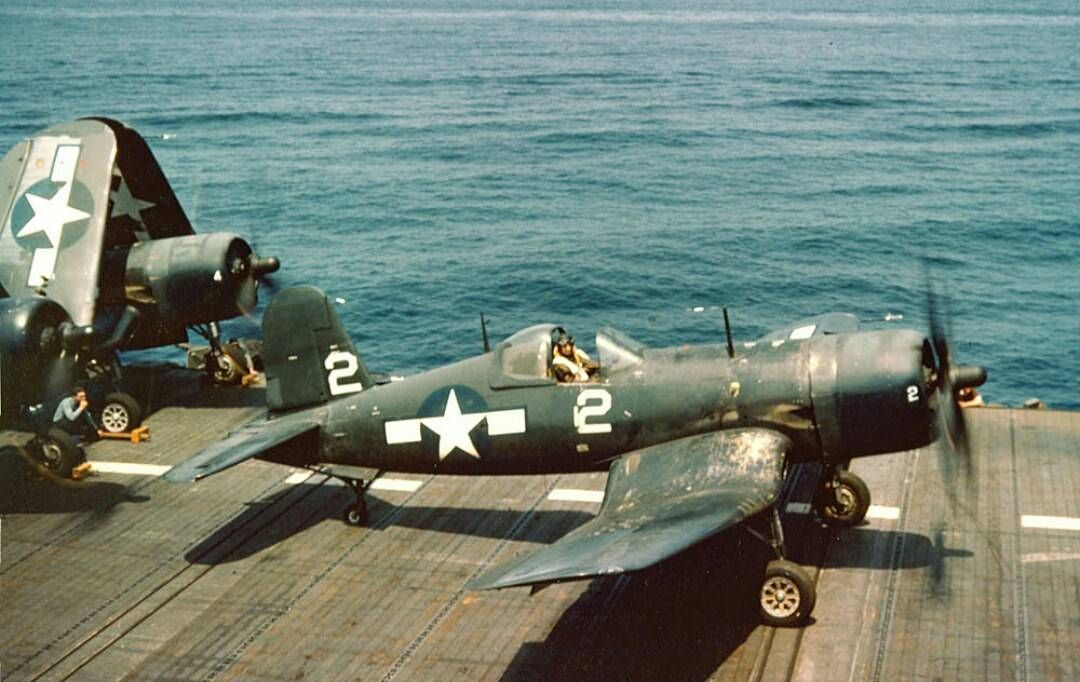| Second World War at Sea:
Carrier Operations, Part Two
By Robin Rathbun
March 2023
 Note: This is the second installment of this look into the nuts and bolts of carrier operations (Rule One: Leave no nuts or bolts on the deck.) The series began here. Note: This is the second installment of this look into the nuts and bolts of carrier operations (Rule One: Leave no nuts or bolts on the deck.) The series began here.
Search and Patrol
American SBD Dauntless dive bombers were their carriers’ primary search aircraft at the start of the war (hence the designation of scouting squadrons). The SB2C Helldiver took over the role when it replaced the SBDs. The versatile TBM Avenger was sometimes used in the search role, particularly from light and escort carriers, but the fleet CVs usually reserved them for the torpedo bomber role given their limited numbers.
The Royal Navy relied on the Fulmar, designed as a reconnaissance fighter, early in the war. They later used Avengers obtained through Lend/Lease.
Japanese admirals much preferred to use all of their carrier-based aircraft in the strike role, in keeping with the offensive spirit of Bushido. Prewar doctrine was to use shore-based long-range flying boats in the air search role, augmented by the floatplanes from attached cruisers and battleships. When operating outside the range of the patrol planes’ own bases (as at the Battle of Midway), the floatplanes became the primary search aircraft. This allowed all of the carriers’ attack aircraft to be used for strikes.
A major shortcoming of Japanese search planning was that it was based on Japanese expectations rather than American capabilities. In the Indian Ocean raid, they expected the British ships to be in port, and that’s where they looked. Their lack of decent search doctrine kept them from finding Admiral James Somerville’s carrier force and likely saved the Eastern Fleet from annihilation. This was unknown to the IJN at the time, of course. At Midway, the Japanese had planned the operation as a surprise attack. They expected the Americans to still be at Pearl Harbor and their June 4th air search was perfunctory at best (only seven planes). After that bitter experience they realized that their search doctrine was inadequate and they began to seriously use carrier aircraft to increase the number of search planes. Their first air search at the Battle of the Eastern Solomons consisted of 19 aircraft, all from the task force carriers. Unlike the U.S. Navy, they normally used torpedo bombers (B5N) in the search role. The fast dive bomber D4Y was also used as a dedicated search aircraft until the structural problems that prevented its use as a dive bomber were worked out.
Early in the war, the US used both SBDs and Wildcats for ASW. Both were largely replaced in the ASW role by the TBF/TBM Avenger, which could carry either bombs or depth charges, plus rockets (from late 1943). The Japanese relied on their floatplanes. The British used the Swordfish and, later, the Barracuda armed with bombs, depth charges or (from late 1942) rockets in the ASW role.

Seafire fighters aboard the British carrier Indomitable.
Strike Operations
The Japanese were the first to use multiple-carrier groups as the fleet’s primary striking arm. Part of the reason that Pearl Harbor came as such a surprise was that only the Imperial Japanese Navy could have pulled off that attack in December 1941, and even they had not been capable of it six months earlier. They had practiced coordinated strikes intensively in the year prior to the war. Air wings in each carrier division (2 CVs) operated almost as a single air wing, capable of combining aircraft from different carriers into a single strike. Normally one carrier would launch all of the strike’s torpedo planes and the other would launch the dive bombers, escorted by fighters from both carriers. A second strike would reverse the mix. This allowed each aircraft type to operate more easily as a single group.
At the start of the war Japan’s Kido Butai (Mobile Force) was made up of three carrier divisions, consisting of Akagi and Kaga, Hiryu and Soryu, and Shokaku and Zuikaku. Although the groups from different divisions did not mix with each other in flight, they carried out coordinated strikes, launching at the same time and arriving simultaneously. They effectively acted as a single huge strike group.
Each strike was commanded by one officer, usually an air observer (not a pilot) in a torpedo bomber. The commander remained at higher altitude to observe the entire attack. He would assign targets, direct the sequence of attacks, and evaluate the results of the attacks.
For the U.S. Navy, multiple-carrier operations were pioneered by TF-17 commanded by Admiral Frank Jack Fletcher in early 1942. They introduced the concept of the “duty carrier,” in which one CV handled the CAP, Search and ASW patrols, with any unused planes held for a strike if an enemy task force was spotted. The other carrier in the task force conducted planned strikes on ground targets, or held her air group on deck, ready to strike enemy task forces when spotted. Since U.S. air groups from different CVs did not combine, this allowed a concentrated strike with a maximum number of planes. The carriers usually alternated days as the duty carrier and, when not in an expected combat zone, the “off-duty” carrier could conduct training and/or maintenance, and rest the crew.
At Midway, Fletcher commanded Yorktown and TF-17, while Admiral Raymond Spruance commanded TF-16 with Enterprise and Hornet. Each task force basically ran its own show. TF-16 had planned to launch a coordinated strike from both carriers, but coordination problems kept them from succeeding, and each of their units arrived at the Japanese task force (if they arrived at all) separately.
The U.S. Navy began to conduct true coordinated strikes only with the arrival of the Essex-class carriers in sufficient numbers. In mid-1943, they conducted exercises off the west coast of the United States in which they operated multiple carriers and air groups. The carrier staffs learned to coordinate launches and the air groups learned to work together to form large multi-carrier strike groups. They developed doctrine for operating groups of up to six carriers together, but in practice their groups were smaller, usually three or four CVs and CVLs.
As they developed coordinated air strikes, the Americans adopted the Japanese practice of having one airborne officer command the strike. This was normally the Air Group Commander (CAG) flying either a fighter or an Avenger.

An F4U Corsair fighter aboard the carrier Randolph, 1945.
American escort carriers (CVEs) were used differently. In ASW hunter-killer groups, they operated singly with groups of destroyers, destroyer escorts and smaller escorts. When used for invasion support, the CVEs operated in groups of up to seven carriers. The groups would launch strikes on pre-selected land targets, or provide airborne “on call” firepower coordinated by forward air controllers accompanying the troops on the ground. They also provided CAP for the invasion force, reconnaissance and spotting for naval gunfire support. In the late war campaigns, the U.S. Navy also used support groups of CVEs to ferry new aircraft from fleet bases to the CV task forces, enabling them to remain on station for extended periods of time.
The Royal Navy early in the war operated completely differently from the US and the Japanese. Normally, their carriers operated singly, as part of combined-arms task forces with battleships, cruisers, and destroyers. Their aircraft protected the task force from (land-based) air attack and searched for enemy task forces. Once an enemy (surface forces only, as the Germans and Italians had no carriers) was spotted, the Swordfish or Albacores would be launched with the objective of damaging and slowing the enemy capital ships with torpedoes so that they could be chased down and engaged by the RN battleships or cruisers. Given the usual Axis lack of air support for surface forces, escort fighters were rarely an issue. This system was well-designed to handle operations in the Mediterranean and Atlantic against the Germans and Italians, but would have been disastrous against the Japanese First Air Fleet. Somerville was wise (and lucky) to avoid contact during the Japanese Indian Ocean raid in April 1942.
The Royal Navy did conduct coordinated air strikes early in the war, but only against fixed targets (port or land strikes). Glorious and Ark Royal operated together off Norway in April 1940, striking targets in the Trondheim area. The Taranto attack in November 1940 was planned using both Illustrious and Eagle, but Eagle had to drop out due to engineering problems and Illustrious carried out the raid alone.
As the war in Europe wound down, the Royal Navy began preparing to take part in the naval war against Japan. They trained intensively, using Lend-Lease Corsairs and Avengers, and learning from American aviators attached as liaisons. They also began using deck parks for their aircraft in order to increase the size of their air wings. This was made possible by the generally better weather in the Indian and Pacific Oceans. The learning was not all one-way. The Royal Navy taught the Americans how to operate Corsairs from aircraft carriers. From November 1944 on, the British Pacific Fleet operated much as the Americans did. In effect, the British Pacific Fleet was a single carrier task force operating in coordination with the U.S. Third or Fifth Fleet.
You can order South Pacific right here.
Quantities are limited.
You can order Midway Deluxe Edition right here.
Sign up for our newsletter right here. Your info will never be sold or transferred; we'll just use it to update you on new games and new offers.
Want to keep Daily Content free of third-party ads? You can send us some love (and cash) through this link right here.
|
